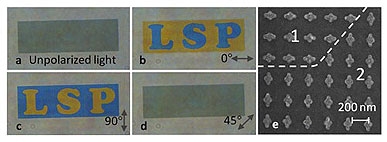Whereas a conventional colour filter can only produce one fixed colour, a single active filter under exposure to different types of light can produce a range of colours.
According to a statement, the advance has the potential for application in televisions and biological imaging and could even be used to create invisible security tags to mark currency. The findings appear in the February issue of Nano Letters.
Kenneth Crozier, associate professor of electrical engineering at the Harvard School of Engineering and Applied Sciences (SEAS), and colleagues have engineered the size and shape of metal nanoparticles so that the colour they appear strongly depends on the polarisation of the light illuminating them. The nanoparticles can be regarded as antennas — similar to antennas used for wireless communications — but much smaller in scale and operating at visible frequencies.
‘With the advances in nanotechnology, we can precisely control the shape of the optical nano-antennas, so we can tune them to react differently with light of different colours and different polarisations,’ said co-author Tal Ellenbogen, a postdoctoral fellow at SEAS. ‘By doing so, we designed a new sort of controllable colour filter.’
Conventional RGB filters used to create colour in today’s televisions and monitors have one fixed-output colour (red, green or blue) and create a broader palette of hues through blending. By contrast, each pixel of the nano-antenna-based filters is dynamic and able to produce different colours when the polarisation is changed.
The researchers dubbed these filters ‘chromatic plasmonic polarisers’, as they can create a pixel with a uniform colour or complex patterns with colours varying as a function of position.
To demonstrate the technology’s capabilities, the abbreviation LSP (short for localised surface plasmon) was created. With unpolarised light or with light that is polarised at 45º, the letters are invisible (grey on grey). In polarised light at 90º, the letters appear vibrant yellow with a blue background and at 0º the colour scheme is reversed. By rotating the polarisation of the incident light, the letters change colour, moving from yellow to blue.
‘What is somewhat unusual about this work is that we have a colour filter with a response that depends on polarisation,’ said Crozier.
The researchers are said to envision several kinds of applications: using the colour functionality to present different colours in a display or camera, showing polarisation effects in tissue for biomedical imaging and integrating the technology into labels or paper to generate security tags that could mark money and other objects.





Nanogenerator consumes CO2 to generate electricity
Whoopee, they've solved how to keep a light on but not a lot else.